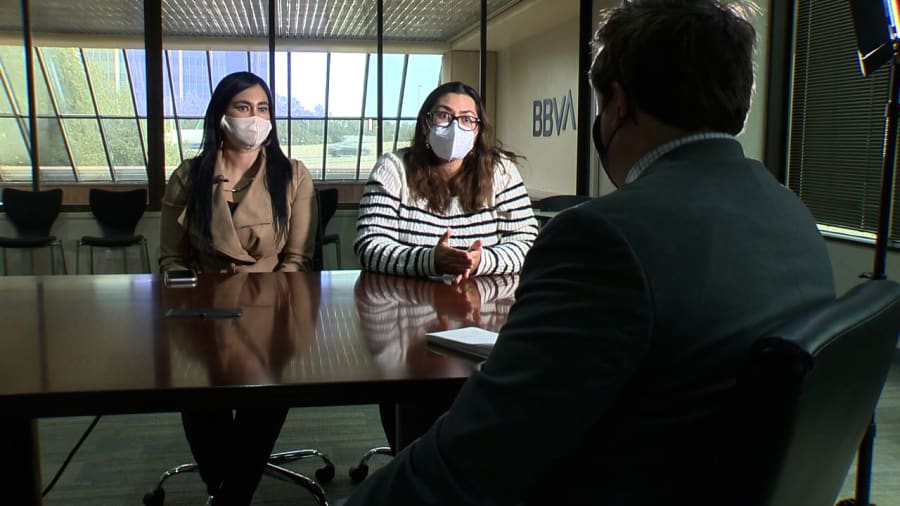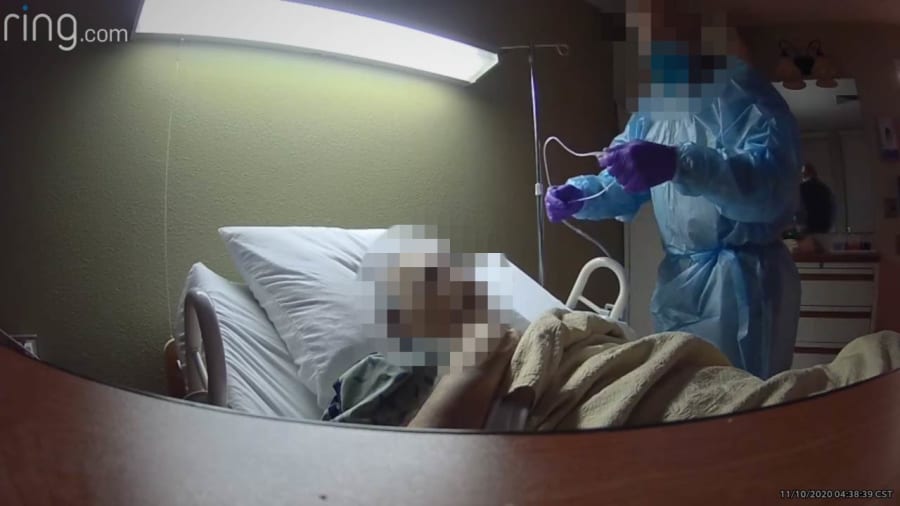SAN ANTONIO – After Rafael Armendariz developed a sore on his foot early last year, his family said management at Golden Estates Rehabilitation & Healthcare Center allowed them to install a Ring security camera in his room to monitor his care and get updates on his condition from staff.
The timing of installing the camera proved prescient, as weeks later, the COVID-19 virus forced nursing homes to no longer allow in-person visits to patients.
Armendariz’s daughters, however, said they had no idea the camera would capture footage on Nov. 10 of their father struggling to breathe and then gasping for air before passing away.
That footage, which has been provided to the KSAT 12 Defenders, is a significant part of formal complaints filed with the Texas Board of Nursing and the Texas Health and Human Services Commission.
The video, captured by the Ring camera as it sat on a table near Armendariz’s bed, shows what happened after breathing tubes supplying oxygen to the 80-year-old fell from his nose.
His daughters, Kesia Armendariz and Arianna Dornbusch, contend that staff at Golden Estates went several hours between conducting face-to-face observations of their father and should have seen sooner that one and then both oxygen tubes had fallen out.
“Watching the video, my dad was already dying and they never helped my dad,” said daughter Kesia Armendariz.

Rafael Armendariz’s family, which has also filed a notice of health care claim with the facility citing a lack of appropriate care and monitoring, plans to also file a formal lawsuit later this year against the Northwest Side facility.
Golden Estates officials have declined to comment on Rafael Armendariz’s death, stating they are prohibited from doing so due to federal health care law.
What the footage shows
Rafael Armendariz, a retired chef with eight grandchildren, had been a resident of Golden Estates since May 2017, his family said.
He had dementia, and according to a San Antonio Police Department report regarding his death, also suffered from diabetes and acute kidney failure.
Rafael Armendariz avoided contracting COVID-19 until early November 2020.
A Ring camera captured footage of a nurse placing a tube under her father’s nose around that time in order to provide oxygen, Dornbusch said.
Staff later told Dornbusch her father would need to be on oxygen around the clock because of breathing issues caused by the virus, she said.
On Nov. 10, one of two cannulas — the thin tubes that deliver oxygen — fell out of Rafael Armendariz’s nose as he lay in bed around 1:30 a.m., according to the formal complaints.
Around 3:08 a.m., the footage shows that Rafael Armendariz lifted his blanket above his head while the other cannula remained in place. When he lowered it two minutes later, the patient continued to put his hand on his face and the breathing tube could no longer be seen, the footage shows.
Within 30 minutes, Rafael Armendariz’s breathing becomes noticeably labored, according to the video. By 4:11 a.m., he is gasping for air.
He appears to stop breathing around 4:25 a.m., the footage showed. Roughly one hour and 17 minutes passed between the time his breathing tube fell out and the time he appeared to stop breathing.
“It’s painful for us to see. We can’t even imagine how other people are probably in the same situation without a camera,” said Kesia Armendariz, who can be heard on the video after 4:30 a.m. imploring staff to check her father’s vital signs.
A staff member appears on screen around 4:38 a.m. and puts the oxygen tube back in place, the footage shows.

Although the staff member proceeds to rub Rafael Armendariz’s sternum and repeatedly attempt to check for his pulse, the patient no longer moves, according to the footage.
Rafael Armendariz was pronounced dead at 5:28 a.m., according to his death certificate.
Kerrville nursing home staffer details ‘missteps’ she believes led to deadly COVID-19 outbreak
Kesia Armendariz also said she repeatedly called the facility that morning and even showed up in person at the building after seeing the distressing video around 4 a.m., but that no one answered her calls or the front door.
Kesia Armendariz can be heard making the same claims on the Ring camera after the staff member appeared on camera and began attending to her father.
The staffer, who at one point can be heard off-camera raising his voice while on his cell phone, told San Antonio police that he was making rounds starting at 12 a.m. and was checking on the patients every two hours.
Rafael Armendariz’s daughters, however, dispute this timeline, claiming in the complaint submitted to the nursing board that their father was last checked on at 12:42 a.m.
The daughters point to the Ring camera timestamp, which they believe proves nearly four hours passed between face to face checks of their father.
The daughters also contend that Rafael Armendariz’s nurse call button was draped over the railing of his bed in a way that they believe kept him from being able to reach it.
An attorney representing the family shared a still image from the Ring camera captured 12 hours before Rafael Armendariz’s death showing the button hanging over a railing and next to the mattress, instead of it being placed on the mattress near the patient’s hand.
When asked about the complaint regarding Rafael Armendariz’s death, an HHS spokesman said via email last month that its investigators have been investigating the facility and actively monitoring it for compliance.
He added that a final report on the investigation would eventually be made public.

Data from HHS, which tracks COVID-19 cases in Texas nursing homes, shows that Golden Estates has kept coronavirus cases relatively contained.
As of Dec. 17, six residents had died of COVID-19 complications and there were only three active cases of the virus among patients and staff, HHS records show.
Eleven other nursing homes in the San Antonio area have already had 12 or more residents die from the virus, according to the data.
Shawn C. Golden, an attorney representing Golden Estates, sent the following statement via email when asked about the allegations:
“The Federal Health Insurance Portability and Accountability Act and Health Information Technology for Economics and Clinical Health Act bar health care providers from disclosing or commenting on the health information of any current or former patient, whether living or deceased. Accordingly, my client is prohibited by federal law from commenting on this matter.”




